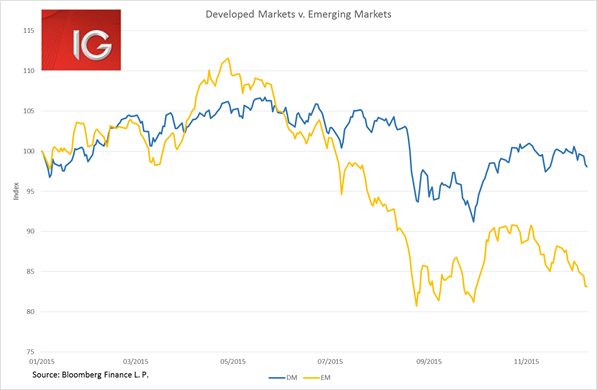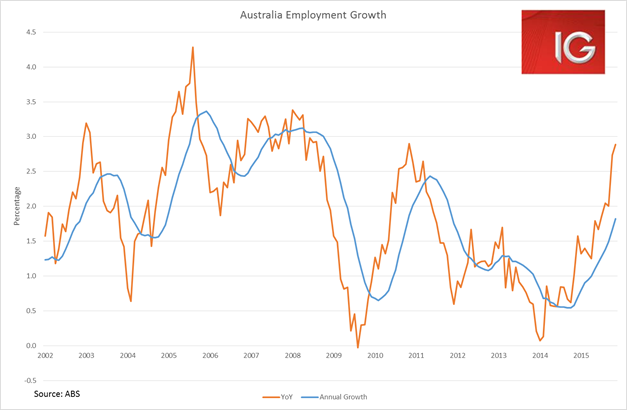Volatility is rising as flows are starting to pick up around expectations for a rate hike by the Fed next week. US dollar long positions looked to be coming out of the markets at a rapid clip over the past 24 hours. Market participants seem to be reaching the conclusion that much of the US dollar strength around a December rate rise is already in the price and there is minimal further upside. Hence, the rate cut by the Reserve Bank of New Zealand (RBNZ) and Australia’s strong employment figures proved to be major catalysts for these currencies surging in a weakening US dollar environment.
The DXY dollar index lost 1.1% over the past 24 hours, which helped provide a fillip to some commodities prices including iron ore and copper. Although the massive selloff in commodities does look to be claiming a few scalps with Anglo American (L:AAL) and Freeport-McMoran Copper & Gold Inc (N:FCX) cutting their dividends and small ASX iron ore miner, BC Iron Ltd (AX:BCI), announcing the closure of its Nullagine Joint Venture with Fortescue Metals Group Ltd (AX:FMG).
But the steady weakening of the renminbi is continuing to make waves. The midpoint for the CNY was weakened a further 0.15% today to a level not seen since mid-2011.
The fact that the CNY is being weakened ahead of the Fed meeting is no surprise. It was precisely because expectations were so high for a September rate hike by the Fed that the People’s Bank of China (PBoC) decided to weaken the currency in August due to the CNY’s de facto US dollar peg. In August, we saw the CNY midpoint weaken 4.6% in a matter of days. Since 2 November we have seen the CNY midpoint weaken 1.7% and the pressing question of the moment is how far the PBoC will weaken the currency on this occasion. Of course, trying to second-guess the notoriously opaque PBoC is akin to playing Russian roulette whilst tied up in a hessian sack. Nonetheless, it does seem a fairly safe bet that the CNY will continue to weaken at least into the 16 December Fed meeting and arguably a midpoint fix in the CNY 6.45-6.5 region by the end of the year would not be entirely out of the question.
Although it is fairly clear that this current Fed and China induced selloff is weighing far heavier on emerging market equities than developed markets.

Australia
The Australian employment data does raise some important questions. Problems with the seasonally adjusted monthly change in employment have been well noted, but even if you were to halve the 71,400 jobs reputedly added in November, the number would have been well above the consensus expectations for a 10,000 job decline. The number did not completely come out of thin air, the ANZ job ads data for the month also showed a strong 1.3% month-on-month (MoM) increase.
The big question is how much momentum is behind these numbers. Whether you take the exact figures at face value or not, it is pretty clear we are seeing some velocity in the numbers that indicate employment is picking up at the fastest rates in four years. Employment growth expanded at 2.9% year-on-year, which ties for the peak monthly employment growth seen in the previous cycle in November 2010. Otherwise, we are at pre-GFC levels of employment. But even the slower moving 12-month total growth rate is at 1.8%, its highest level since November 2011.
In any case, this saw the Aussie dollar jump 1.3% on the data release as the prospects for a rate cut by the Reserve Bank of Australia (RBA) look to be dead in the water. The bond market is currently implying that the likelihood of an RBA rate cut in February stands at 9.3%. At the current juncture, it looks difficult to see the Aussie dollar even dipping below US$0.70 in the near term, and if the domestic data continues to hold up into 2016 calls for the Aussie to drop to US$0.65 or below look increasingly unlikely.

The ASX dropped down to its lowest level since 16 November as concerns about the Fed and potential CNY devaluation wracked global markets. The index broke through the key 5050 level, but did seem to bounce off the 5000 mark – a level it rarely closed below even during the depths of the August/September selloff.
The strong employment figures and the elimination of a potential rate cut by the RBA looked to be taken as a negative for the banks. The lack of further easing and the slowdown in the housing loans data yesterday spells the end of the highly profitable home loan growth for the banks. Financials lost 2% with all the Big Four losing 2% or more.
The slight easing in the US dollar provided a fillip for the materials sector. This helped the two big miners, BHP and RIO, stay in positive territory despite the massive selloff seen throughout the index.
